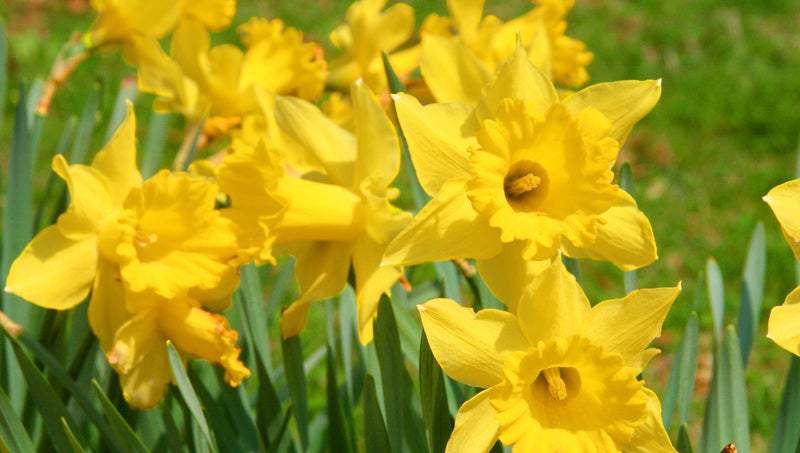Fall is the time to plant spring bulbs
Published 1:56 am Monday, November 7, 2016
The cool air of fall makes gardeners think of planting flowers for spring, not to mention the beautiful bulb catalogues in the mail this time of the year. But even if you can buy bulbs now, you should not plant them until the ground cools; otherwise, they will try to produce flowers before they have established a strong root system.
So, what should you do? The best time to plant here in Washington is in November and December. You can plant bulbs as late as January, but they will bloom later in the spring. If you see bulbs you want in September or October, go ahead and buy them.
Most bulbs today are sold in perforated plastic bags. If not, put them in a brown paper bag with some holes it. Then place them in a cool, dry, dark spot such as the back of a closet until it is time to plant. It is not necessary to put them in the refrigerator. If you are likely to forget them, mark a date for planting in your calendar, or they will sprout in the bag!
Keep in mind that bulbs do not like wet feet, which will cause them to rot. When preparing your planting holes, make sure there is plenty of drainage. If clay soil is a problem, plant in raised beds or pots. The depth for planting bulbs is crucial, or they will not grow properly. Most bulb sellers include the planting depths for each type of bulb on the package. If not, you can follow the old rule-of-thumb and plant each bulb 2.5 times the height of the bulb. Thus, you would plant a 2-inch bulb in a 5-inch hole. When you plant the bulbs, add a little time-release fertilizer in the bottom of the hole, then cover them to the level of the soil around them. You will fertilize them again after they bloom.
Mulch your plantings to help protect them from weather and temperature extremes, and then water them in. You may want to mark your plantings so you can find your flowers in the spring.
Now that you have done all the hard work, your only job is to keep them watered and chase away the little forest creatures that will try to eat all your bulbs, except for the daffodils, which are toxic to them. Pepper spray or sprinkled cayenne, applied after every rain, may help.
These instructions will also work if you are planting your bulbs in pots, but they will need extra protection from extreme temperatures. You can do this by placing the pots in a cold frame or by wrapping the sides with bubble wrap.
After your bulbs are finished blooming for the year, do not even think of cutting the leaves and stems off! Just pinch off the dead flowers and any seed pods, and let all the greenery continue to grow until it dies. The bulbs have exhausted all their resources by blooming, and they need to continue photosynthesis to build up their strength to bloom again next year. And no matter what anyone tells you, do not braid or fold the plants to make them look tidy. If you can’t stand how raggedy they look, put in some plants or small grasses to disguise the leaves. I wish you all a beautiful spring bloom next year!
For more information on bulb selection and planting visit the following sites:
- https://content.ces.ncsu.edu/hints-for-fall-planted-spring-and-early-summer-flowering-bulbs
- https://pitt.ces.ncsu.edu/2015/10/when-do-i-plant-spring-flowering-bulbs/
Edie Miller is a certified Master Gardener volunteer.
The information for this article is given courtesy of the Extension Master Gardeners who are volunteers under direction of the Beaufort County Cooperative Extension. They are available to answer questions concerning lawns, vegetables, trees, ornamentals, fruits, plant problems and diseases, pests, soil and many other horticulture issues relating to gardening in North Carolina. Contact a Master Gardener with questions by leaving a voicemail at 252-946-0111 or email the Master Gardener at beaufortcomg@gmail.com and a volunteer will respond to the inquiries.
The Extension Master Gardeners will have a fresh holiday wreath sale shortly; watch for more information or contact them at 252-946-0111. Order deadline is Nov. 16 with pick up Nov. 23.
Gardening Calendar-November
Note: November is the last month to get a free soil sample until next April.
Lawn Care
• Maintain cool season grasses by mow as needed.
• Keep tree leaves from collecting on your lawn.
• Control fire ants with either a bait or contact.
Fertilizing
• Spread ashes from the fireplace around gardens and bulb bed where soil pH is below 6.0. Avoid acid-loving plants.
Planting
• Plant 1-year-old asparagus crowns in the vegetable garden this month.
• If you don’t use your garden through the fall and winter months, consider planting a cover crop like annual rye, barley or wheat.
• Now is a good time to set out or transplant landscape plants. Be sure to “open up” the root balls on container plants.
Pruning
• The foliage from existing asparagus can be cut down the ground after the first killing frost.
• Cut back herbaceous perennials after the frost kills the tops.
• Any dead or diseased wood can be pruned out anytime of the year.
• Weeds or unnecessary trees should be removed from the landscape.
• Root prune any plants you plan to move next spring.
Spraying
• None
Other Activities
• Take soil samples from your vegetable garden if you haven’t already done so.
• If you have received your soil recommendations, apply lime as suggested. Don’t apply fertilizer until spring.
• Order fruit trees and grape vines now if you wish to plant them in February and March.
• Prepare bird feeders.
• Don’t forget to water evergreens trees and shrubs thoroughly before winter.
• Continue putting the leaves from your yard into a compost bin.
• Poinsettias should be placed in the sunniest room in the house.






